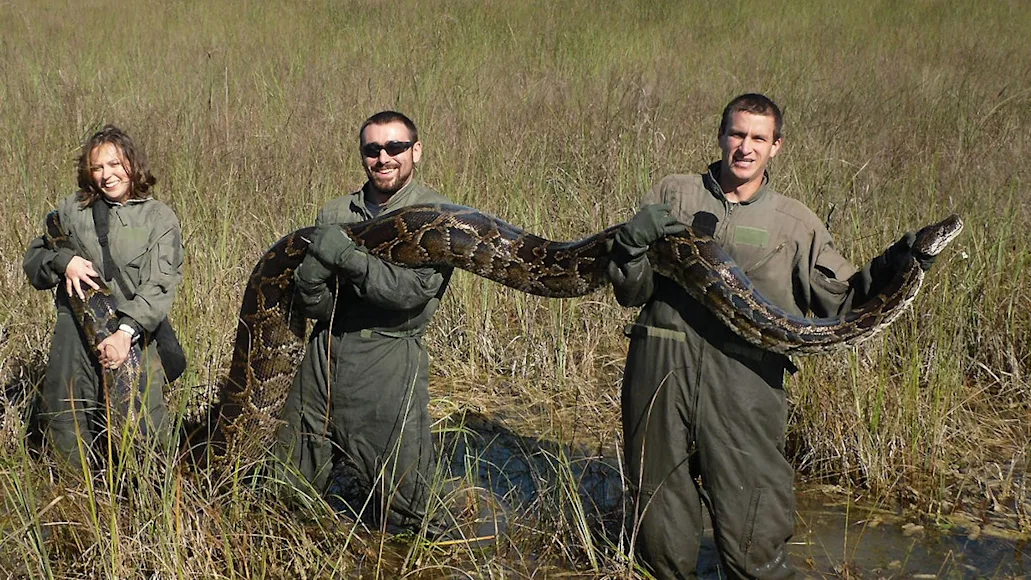Invasive Burmese pythons got loose in the Sunshine State in the late 1970s, and since then, their numbers have exploded. The boa constrictors can grow up to 20 feet long and 200 pounds. They are found primarily in the Everglades ecosystem in South Florida, where they have wreaked havoc on native mammal populations, including marsh rabbits, foxes, and raccoons. In response, local officials have enlisted the support of the species’ only major predator—people. Here’s everything you need to know about hunting giant pythons in Florida.
Related: Bag a Swamp Monster: The Ultimate Guide to Florida Iguana Hunting
Can Anyone Hunt Pythons in Florida?
Florida python hunting is something anyone willing to wrangle a massive snake can do. Not only can you legally hunt pythons 365 days a year on private land and on 25 Florida Fish and Wildlife Conservation Commission (FWC) areas without a permit or hunting license, but you can also compete in a state-sponsored Python Challenge, which offers cash prizes to participants. Python hunting can even become a full-time job. FWC’s Python Action Team pays an hourly wage plus a bonus based on the length of each snake removed to professional python bounty hunters. Donna Kalil, a professional python hunter for the South Florida Water District, has been a member of the FWC Python Action Team since the program started in 2017. She has caught 742 pythons—including a 16-footer—and recorded the time, date, location, temperature, and other information on her captures, along with the weight and length of each snake. She has also introduced both adult and youth hunters to the sport. “I can tell you that basically all the hunters I’ve taken out were not prepared for python hunting, because it’s not even close to the same thing as hunting,” Kalil tells Field & Stream. “In traditional hunting, you’re using a gun or bow to kill your prey from a distance. Python hunting is hands on. You have to catch them first, then dispatch them after you get them under control. It’s totally different.”
How to Find Pythons in Florida

Locating pythons can prove difficult. Python Challenge
Invasive pythons are found primarily in The Everglades, a 1.5-million-acre swathe of sawgrass marsh, sloughs, cypress swamps, hardwood hammocks, and pinelands. Pythons utilize every bit of it, including the water, which can make them difficult to find. The most popular method for python hunting in Florida is driving roads with spotlights on summer nights. “For most people, that’s the best chance of catching a python,” Kalil says. “But there are so many people doing that now, that I think it’s more enjoyable hunting to go out on foot looking for breeding balls.”
Breeding balls are writhing masses of snakes that occur when multiple males engulf a breeding female. They can be spotted from a distance in fields in February and March. In April, Kalil shifts tactics and targets that are on the move in search of prey. In summer, hatchlings emerge. “That’s the time to drive along looking for little baby pythons coming up on the road,” she says. The best time of day to hunt is highly dependent on temperature. “If the temperature is 75 degrees or below, then I’m not gonna hunt at night. If it’s above 75 degrees, then I start my hunt right at sundown.”
How to Safely Catch a Python
The most important thing to keep in mind when hunting pythons in Florida is grabbing the right part of the snake. “I’m a snake lover, so I always cringe at seeing guys grab ’em by the tail and swing ’em around,” says Kalil. “If you do that, they’re gonna get a heck of a lot more agitated, and you’re going to risk getting bit.”

Don’t grab a python by the tail. Python Challenge
While pythons are nonvenomous, their bites can still inflict serious damage. The fangs of a big snake can cause significant tissue damage and even, life-threatening blood loss. When hunting pythons in Florida, Kalil goes straight for the head, even if she has to spend some time getting into position on a snake buried in cover. “If you’ve hunted stealthily and the snake is calm, you can usually walk right up beside them nice and slow without them bolting. It’s when you put your hands on them that they go ballistic.”
Anything over 10 feet is going to put up a stout fight, and Kalil says she even got into trouble once with a 7-footer, which wrapped itself around her neck when she got distracted by a phone call. Anything over 14 feet is a “monster” in her book—and a two-person job for most hunters. “If it’s a big one, you better have someone along to keep those coils off you, because it can get very deadly,” she says. “If you’re by yourself and a python wraps around you, and you can’t get it off, the best thing to do is just let it go. It will generally take off if it gets an opportunity because it isn’t out to hurt you. You might get bit, but you won’t get killed.” To be extra safe, she tapes shut the mouths of big snakes before dispatching them.
How to Dispatch a Snake
While professional hunters like Kalil are allowed to transport pythons alive, Florida regulations require amateurs python hunting in Florida to humanely kill the snakes where they’re captured. The Florida Fish and Wildlife Commission (FWC) recommends a two-step process: First, render the snake unconscious with a blow to the head, and then deploy a sharp object to destroy the brain. A captive bolt stunner, firearm, or metal mallets can be used for step one. Accuracy is crucial. Pythons have a very small brain, much like an alligator, and if you don’t score a direct hit the snakes can take off on you.
For step two, the FWC says you should use a small rod, which could be a screwdriver or something similar, to spike the cranial cavity. You should then move the rod back and forth and in circular motions to scramble the brain. Don’t cut off the head. A decapitated reptile can survive for almost an hour, and it could be conscious. There are even reports of people getting bitten by a snake they’ve just decapitated.
Read Next: Florida Researchers Tracked Down and Killed a Giant Burmese Python After it Ate a Collared Possum
How to Participate in the Florida Python Challenge
For most people, the annual Python Challenge is a great way to start python hunting in Florida. The competition’s $25,000 in prize money attracts a lot of experienced python hunters, but the mandatory online training requirement and optional in-person training sessions also make the annual August tournament a good place for newbies to dive in. During last year’s challenge, Kalil won $750 for capturing the second most pythons in the professional category—six snakes. The Ultimate Grand Prize of $10,000 went to Matthew Concepcion, who captured 28 snakes. The 2022 challenge drew about 1,000 participants from 32 U.S. states and two foreign countries who removed 231 of the invasive predators from the Everglades.


